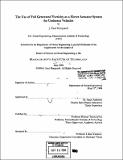The use of foil generated vorticity as a hover actuator system for undersea vehicles
Author(s)
Marquardt, J. Paul (Joseph Paul), 1975-
DownloadFull printable version (9.827Mb)
Other Contributors
Massachusetts Institute of Technology. Dept. of Ocean Engineering.
Advisor
Jamie Anderson.
Terms of use
Metadata
Show full item recordAbstract
The hover actuator system is a proof of concept platform. The design models the ability of a flapping foil to assist an undersea vehicle's shallow water sea-keeping performance. Goals of this study are to demonstrate an effective regime of foil motion amplitude, frequency, pitch angle offset, pitch angle amplitude and phase angle for two types of motion. Using the time-averaged thrust coefficient, I find that the lower frequencies provide the highest thrust coefficient of 3.1 at G0=600, hdc= 1.5, and f=0.4Hz for the treading water mode. Significantly lower thrust coefficients are observed for the figure eight mode with maximum of 1.8 occurring at G0=300, hdc=1, and f-0.2Hz. In addition to finding the optimal regime of thrust coefficient, the total thrust is also analyzed to find the regimes of absolute maximum thrust. Again, for the water treading mode the peak thrust was 24Newtons at 00=600, hjc=2.5, and f=0.6Hz; and for the figure eight mode the peak thrust of 7.5Newtons occurs at 00=450, hdc=2.7, and f-0.2Hz. Finally, the rationale of using such an apparatus, arguments, and test results are discussed in conclusion.
Description
Thesis (S.M.)--Massachusetts Institute of Technology, Dept. of Ocean Engineering, 1998. Includes bibliographical references (p. 88-89).
Date issued
1998Department
Massachusetts Institute of Technology. Department of Ocean EngineeringPublisher
Massachusetts Institute of Technology
Keywords
Ocean Engineering.